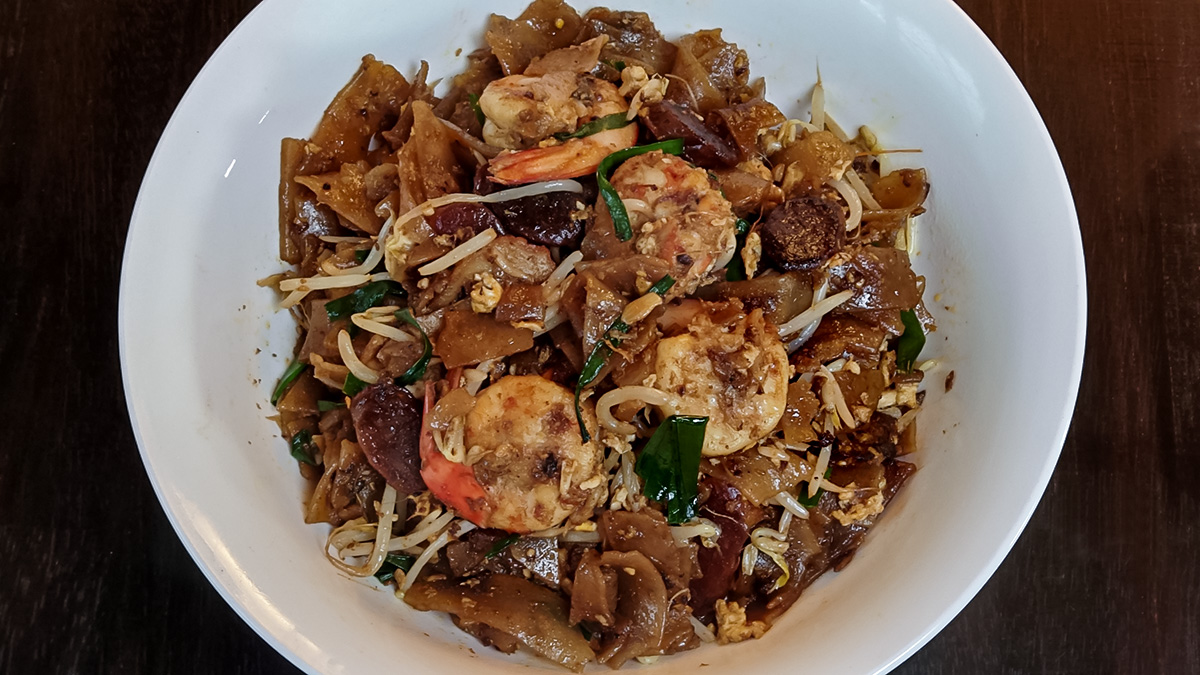Clem's
Penang Style Char (Fried) Kway Teow (rice noodles)
Penang Char Kway Teow (rice strips/noodles) is an iconic Malaysian dish. While rice noodles fried with soy sauce can be found all throughout Malaysia, it is the Penang version which is recognised nationwide. The dish is thought to have originated from the Fujian Province in Southern China, brought overseas by the Teochew and Hokkien diaspora. Down the south of China, rice predominates as the carbohydrate source and thus rice and rice noodles rather than breads and wheat noodles feature in the cooking from that region.
Vendors outside Penang will often advertise their noodles as "Penang" only for their diners to find the version wanting.
Here are the materials and method which should form the basis of your reproducing the archetypal Penang Char kway teow.
INGREDIENTS
For one serving, and for a halal version omit all pork products:
The frying oil
It is not essential to make this oil for frying the dish but it will surely up the taste experience closer to the real McCoy.
- Prawn heads saved
from previous cooking episodes
- Some pork lard
- A cup or two of
cooking oil
The chilli paste
- Two dried chillis
(softened by soaking in water)
- Two or more fresh
chillis
- Half a red onion
The noodle fry
- Two large eggs
- Two handfuls of
loosened rice noodles (kway teow)
- A handful of
chives, cut into small lengths
- Two handfuls of
bean sprouts (well drained of water)
- Some fish cake,
sliced into strips
- Some Chinese dried
pork sausages (lap cheong) sliced into strips
- Four large, shelled prawns
(or you may choose chicken or even beef if you wish to avoid
prawns - remember that authentic Penang Char Kway Teow
is fried with prawns)
- Chopped garlic
- and if you have
them handy, a handful of fresh blood cockles
METHOD
Chilli paste
- Place the dried
(soaked) and fresh chillis with the red onion into a
blender.
- Add water as
necessary to encourage blending.
- Blend until a
smooth paste results.
Prawn frying oil
- Add the prawn heads
to a suitable pan (the oil will splatter so a high-walled
receptacle will be best).
- Add the cooking oil
and start the fry at sufficient heat to render the prawn
heads nicely brown and crispy.
- Use a sieve or
strainer to separate the oil from the prawn heads.
- If using pork lard,
add this to the recovered prawn oil before it cools down.
Mix well.
Char Kway Teow
Sauce
Do not fry with just plain soy sauce: learn the secret of Penang
hawkers - they use a blend of sauces -
These are recommended starting proportions; experiment to get the taste which suits you best.
- Take two
tablespoons of dark soy sauce, to it add
- One tablespoon of
light soy sauce,
- One tablespoon of
fish sauce,
- One tablespoon of
oyster sauce,
- and if not averse
to it,
One teaspoon of MSG
- dash of white
pepper,
- and one tablespoon
of water (if you like a lighter colour in your fry and a
less salty taste).
Frying
the noodles
All on a high heat setting -
- Add two table
spoons or more of prawn oil to a wok and heat it up.
- Fry the lap
cheong and fish cake slices.
- Add a good handful
of chopped garlic and fry momentarily (do not let the garlic
burn).
- If a spicy version
is desired, add the chilli paste now and fry.
- Add the prawns.
- After a minute, add
two handfuls of loosened rice noodles.
- Fry for a minute or
two.
Add splashes of water to help steam up and cook the noodles well (they are actually already cooked when made).
Different brands of rice noodles differ in their consistency and "chewiness" depending on composition (rice flour to tapioca flour ratio) and water content. Thus, some rice noodles need a longer frying time (with steam).
Do avoid adding too much water in case your noodles end up soggy, and your wok turning sticky from starch released from the noodles.
- Now add a couple of
tablespoons of Char Kway Teow sauce.
- Continue to fry to
bring up the flavour of the Char Kway Teow sauce.
- Now add handfuls of
bean sprouts and chives.
- Continue to fry
until the vegetables are half cooked.
- Push noodles to one
side of the wok.
Add prawn oil to the freed up side of the wok and add one or two eggs to fry.
Break the egg yolks up as you fry.
- After a few seconds
push the noddles onto the eggs and mix well.
- Fry until the eggs
are no longer wet.
- If you have them
and wish for that Penang touch, add the fresh blood cockles
now and toss them in the noodles just a few times so that
they are not overcooked.
- Do a final taste
test and adjust the noodles for oiliness/wetness by adding
more water or prawn oil as necessary and frying on.
- Serve and enjoy.

Clem's Penang Style Char Kway Teow
All my cooking (some without recipes) can be found here (click on each photo to go to that dish's page):
http://clemkuek.com/photoalbum/photo696.html
Video presentations can be found here:
Earlier days: https://youtu.be/BWyHY1h9Y5s
More recently: https://youtu.be/cph2XmwuQLU
04 January
2025
Created by Clem Kuek
